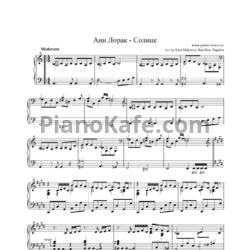
Noti Dlya Fortepiano Pesni Ani Lorak Solnce
[34] ACkPygEYGVNjvE 投稿者:buy viagra cheap 投稿日:2012/02/20(Mon) 13:38 4, what is cialis, 500, http.
This post is a tribute to one of my favorite sketchbooks: Canson Art Book Universal. I’ve gone through 3 of these sketchbooks since I first discovered them in 2012, and none of the other ones I’ve used so far have lived up to its versatility. It’s no secret that sometimes I don’t do art for months. There are objective reasons, and emotional reasons, and totally silly reasons, but whatever they are—the result is the same: no new art, guilt and shame because I’m not making art, and overall grumpy feeling and lack of enthusiasm because I need my art. In the interest of documenting my methods for the future when it’s bound to happen again, but also to help others who have the same problem, I’ll talk about what I’ve tried and what helps me start again after a long period of not creating.
Oct 23, 2017 Rozhodne se jedna o radost, protoze se testeri hry konecne dockali 2 novych modu ve hre (Kampan,Interaktivni mod) Ja jsem nevahal otestovat Kampan a. Banki semplov dlya nexus 2. Mar 01, 2018 xda-developers Android Development and Hacking Android Apps and Games MEmu 2.7.2 + Android 4.2.2 (Download page) This is a back up of the older version. By Dunard XDA Developers was founded by developers, for developers. Browse » Home » Design » Free Download Software Vocaloid 2 + Voicebanks Full Version. Free Download Software Vocaloid 2 + Voicebanks Full Version Download software. Free Download Software Vocaloid 3 + Voicebank. Free Download Autodesk Maya 2015 Full Version.
Latest creations • • • • • •. Get the free chapter of my new book “The Human Centered Brand” is a guide for service-based business owners who want to craft an authentic brand that’s rooted in their values, and leverages their unique personality. Enter your contact details below, and the free chapter, workbook, checklist, and other bonuses will be sent to your inbox right away! Optionally, you may choose to subscribe to regular email updates with branding tips, articles, resources, workshops, etc. You also have the option of receiving with articles on art, design, cultivating creative productivity and growing your business, plus exclusive members-only content and special offers delivered via email. Your name Your e-mail.
The CAP, which oversees subsidies to farmers in Europe, is a complex bureaucracy favouring large businesses over small farmers, pushing them towards intensive farming practices that harm the environment and lead to unemployment. Such criticism does not come from green activists. It was printed almost word for word in brochures of the European Commission in 1998, in preparation for a reform of the CAP. Adobe photoshop cs5 language pack engb itunes login. The reform was enacted in 1999. Less than 15 years later, in 2013, the same problems were addressed in yet another reform.
The talk was to make the CAP “greener” and provide more support to small farmers. A long-term review of agricultural data in Europe shows that the problems identified in the 1990s have not been solved. They were even made worse in the countries that joined the European Union after 2004. Since 2000, cereal production in the European Union increased from 200 to 300 million tons per year.
At the same time, the production of fruits and vegetables decreased, from 100 to 85 million tons per year, even though the European Union itself expanded from 15 to 28 countries. One reason for this evolution lies in the way the subsidies are given out by the European Commission. Before the 1999 reform, subsidies were given by volume. The more farmers produced, the more subsidies they received. After the reforms, most subsidies (so-called “direct subsidies”) were given by hectare: the larger the farm, the larger the subsidies. This, along with other factors like the demand for biofuels and increased meat production, pushed farmers towards crops that require large fields, like cereals and oilseeds. While the total area under cultivation in the European Union barely increased between 2005 and 2013, the average size of each farm increased from 12 to 16 hectares.

Some countries saw much larger increases. These averages hide the dominance of extremely large farms. Of the 10 million farms active in the European Union in 2013, the vast majority were extremely small. In most countries, farms larger than 100 hectares control most of the land and, with the exception of Austria, their share has grown in recent years. The CAP is not the only reason for these changes, but the policy provides more benefits to large farms growing cash crops than to smaller ones. The European Commission correctly points to the fact that programmes are in place to support small farmers but it fails to see that the complexity of the procedures de facto prevents small farmers from understanding what they can claim and receiving money. Cash crops, such as cereals and oilseeds (sunflower, rapeseed), require high investments in capital, large fields and little manual labour.
At the opposite end, vegetables and fruits require intensive human care to grow and harvest. The drive to grow cash crops accompanied a dramatic reduction in employment in agriculture. Since 2000, the total employment in farms across the European Union decreased by 6 million full-time equivalents. All of the decrease was borne by non-salaried farmers, such as seasonal workers. As the production of fruit and vegetables decreased in the European Union, imports grew substantially. Imports of fruit and vegetables more than doubled in value, from €10 billion in 2000 to €23 billion in 2015. (Imports of cereals increased too, but imports represent a much smaller share of European consumption relative to homegrown cereals).